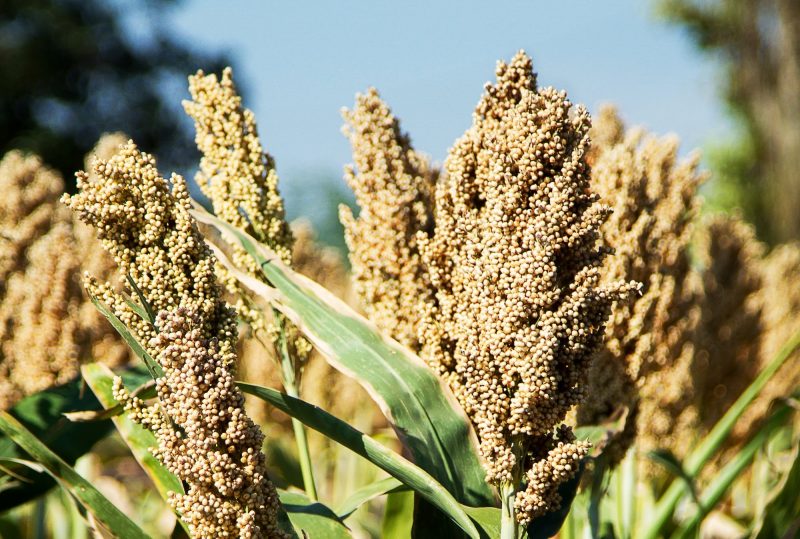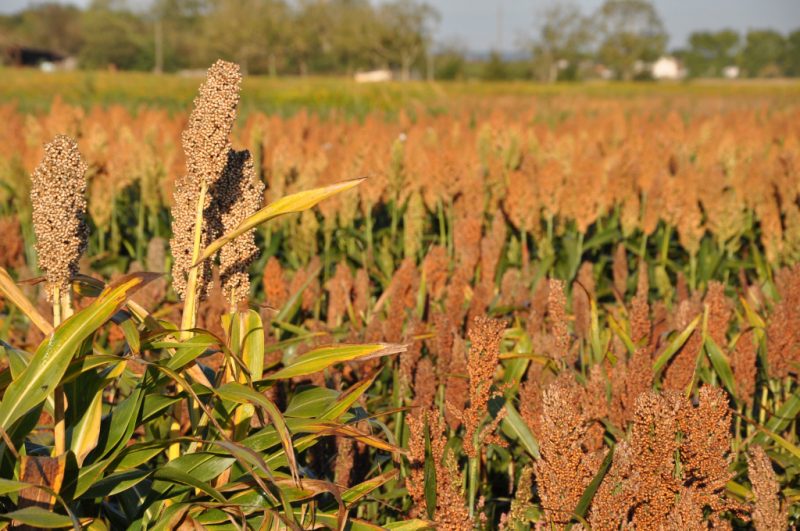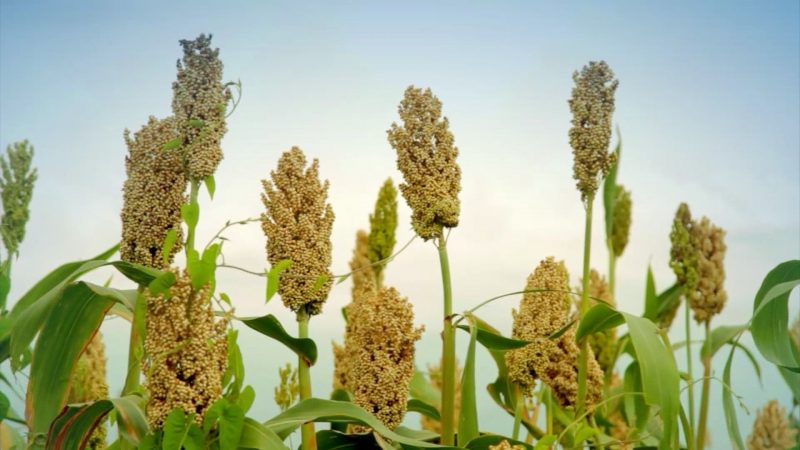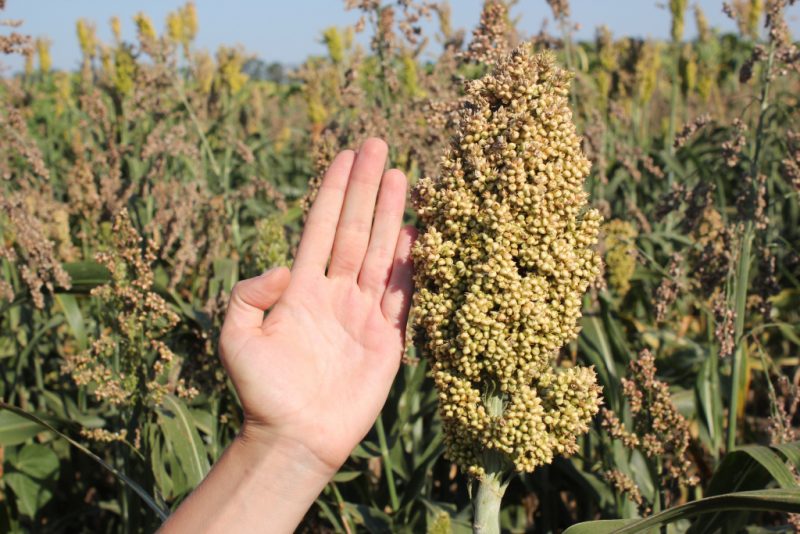Sorghum is a promising crop that can withstand drought without harming the crop. Grain sorghum contains a large number of useful substances that help maintain the health of the body, and feed varieties are indispensable in animal husbandry. How to grow sorghum, it is useful to know the farmers who are interested in this culture.
Material Content:
Sorghum - what is it?
What is sorghum, not all residents of Russia know, and they only grow this cereal in several regions. This herb is native to Equatorial Africa and belongs to the Cereals family. There are about 30 types of sorghum that are grown as bread, industrial and forage crops.

Brooms are made from sorghum. Outwardly, its stems look like corn, only without heads of cabbage. Whisk with seeds resembles millet, and the grain is suitable for food. From the stems of sugar sorghum make sweet syrup for baking. There are modern hybrids whose stems reach 4 meters in height (Purumbeni).
The plant is drought tolerant and easily adapts to any soil. The optimum air temperature for seed germination is + 20 ° C. Spring frosts can destroy seedlings, so you can’t rush to sowing dates.
A feature of the plant is a slow growth at the beginning of development and its complete stop under adverse conditions.
In Russia, cereals are grown in the southern regions - Samara, Saratov, Rostov, Volgograd. Freezing in spring can lead to the destruction of crops. Sorghum has a long growing season (80 - 140 days), and in the north it does not have time to mature. The crop is sown in the fields where barley, wheat, legumes and potatoes used to grow.
Calorie content and chemical composition
The most nutritious bread varieties of sorghum.In Russia, they are grown only in the Saratov region, because in other regions the cereal does not ripen. 100 g of dried grains contain 323 kcal (boiled about three times less).

The chemical composition of cereal:
- proteins - 10%;
- fats - 4%;
- carbohydrates - 60%;
- dietary fiber - 3.5%;
- water - 13.5%;
- B vitamins, biotin;
- mineral salts K, Ca, Si, Mg, Na, Ph, Fe, Co, Mn, Cu, Zn.
Some varieties of sorghum have a dense, bitter shell, which must be removed before cooking. This reduces the content of beneficial vitamins and mineral elements in the grain.
Groats, starch and flour are made from sorghum. Before cooking porridge, cereals are soaked and washed. Gluten is not found in sorghum flour, so it is mixed with wheat for baking soft bread.
Description and types of plants
Sorghum is a thermophilic culture, it easily adapts to various soil, tolerates drought well. The plant stem has a height of 50 cm to 7 meters in some tropical species.

Inside the stalk of sorghum is filled with loose plant tissue - parenchyma.
Varieties of sugar sorghum retain the juiciness of the stem at the stage of grain maturation. They are suitable for sweet syrup.
Sorghum root can grow to a depth of 2.5 meters, extracting the necessary moisture and nutrients for the plant. The leaves of the plant are lanceolate, with sharp edges. It takes about 4 months from sowing to ripening.
The diverse types of sorghum crops are divided into 4 large groups depending on economic use:
- grain sorghum;
- sugar sorghum;
- grassy sorghum;
- technical or broom sorghum;
- lemon sorghum.
However, such a classification, proposed in the post-Soviet space in the middle of the last century, is not the only possible one.
Useful properties of sorghum
Sorghum grain has a unique chemical composition, it contains a lot of mineral salts, vitamins, polyphenolic compounds, unsaturated and saturated acids.

Thiamine contained in grain favorably affects the activity of the central nervous system, normalizes the functioning of the heart and improves appetite. Riboflavin helps maintain healthy hair, skin, and nails.
Lemon sorghum contains citral, which gives it a pleasant citrus aroma. Shredded plant stems are used in cooking as a gourmet spice.
Sorghum is a good antioxidant. The polyphenolic compounds included in its composition strengthen the immune system and protect against adverse factors. But there is a disadvantage in cereals - it is poorly digested. Sorghum has a special kafirin protein, which is not very well absorbed in the body.
Growing Sorghum

Grain cultivation begins with the preparation of soil and seeds for planting.
- Chaffing is carried out to preserve moisture in the soil. When shoots of weeds appear, make cultivation.
- The second cultivation is done on the day of sowing sorghum to a depth of 5 cm, then they are rolled using a ring roller.
- The grain is divided into fractions, as this affects the germination.
- 2 months before the start of sowing, seeds are treated to destroy pests and microflora, which can reduce the number of seedlings.
Sowing time depends on weather conditions and the characteristics of the variety; grain is sown manually or using special equipment. The rate of emergence of seedlings depends on the temperature of the soil: at + 14 ° C they will germinate on day 10, and at + 28 ° C on the 5th day.
It is not recommended to plant sorghum seeds deep in the soil, the optimal sowing depth is 5 cm. The row spacing during sowing is on average 60 cm.
Further care is to control weeds, pests and diseases. Processing with mounted cultivators begins when shoots appear, adhering to the width of the protective zone of 12 cm.
The culture has strong immunity, but young crops need to be carefully examined to notice the onset of the disease in time and eliminate it.
The main diseases of sorghum include:
- root and stem rot;
- smut;
- fusarium and alternariosis;
- rust.
Sorghum Pests:
- cereal flies;
- meadow moth;
- wireworms;
- cereal aphids;
- caterpillar scoop.
Green mass for livestock feed is mowed from mid-July to the end of August. To harvest more, the seeds are sown in several passes with an interval of 10 days.
Brooms are made from ripe panicles of technical sorghum, drying them previously in a dry room for about a month.
Sorghum grain is harvested after full maturation, and silage harvesting is collected upon the onset of milk-wax ripeness.












